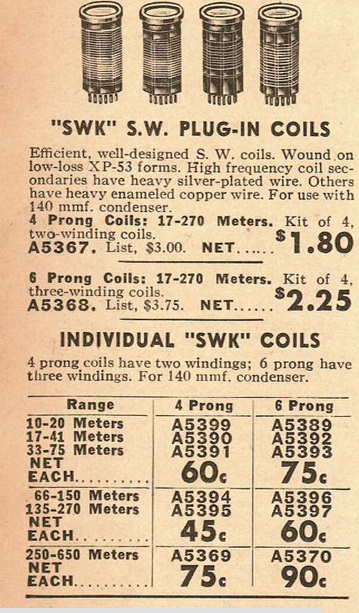
 Many of the vintage receivers described here require plug-in coils, such as the ones shown in the image at the left. Back in the day, these were readily obtainable in common sizes. And as the February 1941 issue of Popular Mechanics pointed out, “considerable effort can be saved by purchasing ready-wound coils.” However, he magazine also admonished that “the beginner should take the time to wind the coils for at least the first set he builds so that he will understand exactly how they are made,” as the young gentlemen shown at the top of the page are doing.
Many of the vintage receivers described here require plug-in coils, such as the ones shown in the image at the left. Back in the day, these were readily obtainable in common sizes. And as the February 1941 issue of Popular Mechanics pointed out, “considerable effort can be saved by purchasing ready-wound coils.” However, he magazine also admonished that “the beginner should take the time to wind the coils for at least the first set he builds so that he will understand exactly how they are made,” as the young gentlemen shown at the top of the page are doing.
Today, since pre-manufactured coils are unobtainium, the builder of one of these sets has little choice but to make the coils at home. But as the experimenter 75 years ago learned, the process of making coils is quite simple. This article serves as a good guide for the modern recreator to make the coils. But there is still a slight problem, since the article simply advises purchasing “forms usually made of Bakelite or similar material.” And those coil forms are also unobtanium today.
Fortunately, modern materials come to the rescue, since it’s easy to recreate the forms themselves using readily available PVC tubing, along with the base of a defunct tube. Complete instructions can be found on AA8V’s page.
Click Here For Today’s Ripley’s Believe It Or Not Cartoon

Pingback: 1936 One-Tube AC-DC Regenerative Receiver | OneTubeRadio.com
Pingback: 1931 One-Tube “Triflex” Shortwave Receiver | OneTubeRadio.com
Pingback: Three 1943 One-Tube Receivers | OneTubeRadio.com
Pingback: 1978 Two-Transistor Shortwave Regen | OneTubeRadio.com
Pingback: 1968 “DX Devil” | OneTubeRadio.com
Pingback: 1943 One Tube AC-DC Shortwave Regen | OneTubeRadio.com
Pingback: 1934 “Globe Trotter” Two Tube Regen | OneTubeRadio.com
Pingback: 1934 One Tube Regen | OneTubeRadio.com
Pingback: 1944 One Tube AC-DC Receiver | OneTubeRadio.com